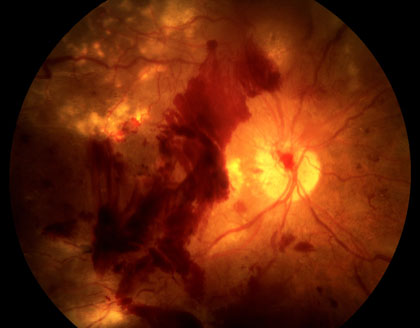Diabetic Retinopathy
/What is Diabetic Retinopathy?
Diabetic Retinopathy is a disease of the retina. The retina is the nerve layer that lines the back of your eye. It is the part of your eye that “takes pictures” and sends the images to your brain. Many people with diabetes get retinopathy. This kind of retinopathy is called diabetic retinopathy (retinal disease caused by diabetes).
Diagnosis
An eye exam by an eye specialist (ophthalmologist or optometrist) is the only way to diagnose diabetic retinopathy. Having an eye exam every year can help find retinopathy before it changes your vision. Specialized testing such as fluorescein angiography, optical coherence tomography and ultrasonography may be required to determine how bad the eye is affected and to select the best treatment options.
Who is at risk?
Every patient with diabetes is at risk for developing diabetic retinopathy. The higher the blood sugar, the faster you will develop the disease. While most are diabetic for 10 years before the retina is affected, some develop it after just a few years or months. Diabetic retinopathy happens when high blood sugar damages the tiny blood vessels of the retina. When you have diabetic retinopathy, high blood pressure can make it worse. High blood pressure can cause more damage to the weakened vessels in your eye, clouding more of your vision. High levels of fat in the blood, smoking, and obesity are also risk factors as are certain medications.
Signs and Symptoms
The signs of diabetic retinopathy (DR) include blood spots, fluid (edema) and abnormal blood vessel growth. Fluid threatening the center of vision is termed clinically signifcant diabetic macular edema (CSME) and requires treatment. Poor circualtion from damaged blood vessels leads to abnormal blood vessel growth termed proliferative diabetic retinopathy and usually requires treatment as well. The symptoms range from no change in vision to some blurring of vision with macular edema to black dots floating in the vision and mild to severe, even complete vision loss. Don’t wait for symptoms. Be sure to have a comprehensive dilated eye exam at least once a year.
Treatment
You may not need treatment for diabetic retinopathy when the changes are early. In more advanced cases, surgery, laser treatment, or medicines may help slow the vision loss caused by diabetic retinopathy. You may need to be treated more than once as the disease gets worse. The goal of treatment is to reduce the rate of vision loss or to stabilize vision. In select patients, such as those with severe swelling of the retina or blood filling the inside of the eye, dramatic improvement in vision may be possible.
Unfortunately, Diabetic retinopathy remains the leading cause of blindness in the working age, and even with excellent care, further vision loss may occur. However, newer treatments are now available that have been known to restore vision in some patients. We specialize in these therapies here at the Retina Macula Institute.

